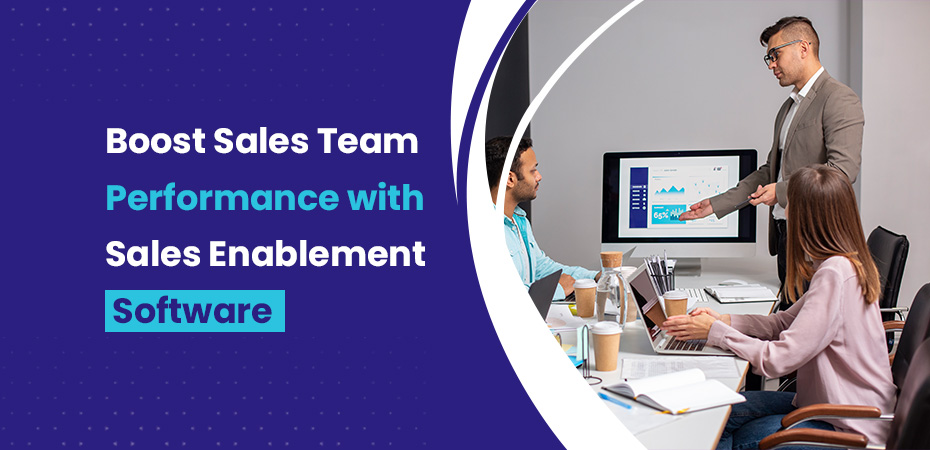Boost Sales Team Performance with Sales Enablement Software



Are you looking to supercharge your sales team’s success? Let’s talk about sales enablement software – your secret weapon for driving better results.
Think of sales enablement software as your sales team’s digital command center. It’s a powerful platform that brings together all the tools, resources, and training your sales reps need to close deals faster and more effectively.
Here’s what makes it a game-changer:
- Smart Resource Management: Instant access to sales materials, presentations, and customer data
- Automated Training Systems: Built-in learning tools to keep your team’s skills sharp
- Performance Tracking: Real-time insights into what’s working (and what’s not)
In today’s fast-paced digital marketplace, sales enablement software isn’t just nice to have – it’s essential. Companies using these tools see up to 66% higher quota achievement and 15% faster sales cycles.
Ready to transform your sales performance? Let’s dive into how sales enablement software can revolutionize your team’s approach to selling.
Sales Enablement- Definition and Components
Sales enablement means a strategic approach that equips your sales and marketing team with the tools, knowledge, and resources they need to sell effectively. It serves as a link between your sales strategy and actual sales success.
Here’s what makes up a robust sales enablement management framework:
1. Content Management
This involves organizing and managing all the sales enablement content strategies that your sales team needs to engage with prospects and customers. It includes:
- Sales presentations
- Product documentation
- Customer case studies
- Email templates
- Proposal frameworks
2. Training and Coaching
Continuous learning is essential for sales professionals. This component focuses on developing their skills and knowledge through various training methods such as:
- Skill development programs
- Product knowledge sessions
- Role-playing exercises
- Performance feedback loops
3. Technology Integration
Leveraging technology can greatly enhance your sales process. This involves integrating different tools and platforms that your team uses, such as:
- CRM systems
- Analytics tools
- Communication platforms
- Document sharing solutions
4. Process Optimization
Streamlining your sales processes can lead to increased efficiency and effectiveness. This component includes activities like:
- Sales workflow automation
- Best practice guidelines
- Performance tracking
- Resource allocation
Sales enablement transforms your sales process from a scattered approach to a streamlined system. It creates an environment where sales teams can access what they need, when they need it – from customer insights to marketing materials.
The real power of sales enablement comes when all these components work together seamlessly. Your sales reps spend less time searching for information and more time building meaningful customer relationships. They’re equipped to handle customer questions confidently, present solutions effectively, and close deals faster.
The Benefits of Sales Enablement Software
Sales enablement software transforms sales teams into high-performing revenue generators. Research by Highspot reveals companies using sales enablement tools experience a 32% increase in quota attainment and 23% higher lead conversion rates.
Let’s explore the key advantages:
1. Revenue Growth & Sales Performance
- 75% of companies report increased sales within 12 months of implementation
- Teams achieve 49% win rates compared to 42.5% without enablement tools
- Average deal size increases by 35% through better prospect engagement
2. Productivity Enhancements
- Automated task management saves 5+ hours per week per rep
- AI-powered content recommendations cut prep time by 60%
- Smart scheduling tools reduce administrative work by 28%
- Integrated analytics help identify winning sales strategies
3. Accelerated Onboarding & Training
- New hire ramp-up time decreases from 9 months to 6 months
- Digital learning platforms enable self-paced skill development
- Interactive training modules boost knowledge retention by 25%
- Real-time coaching features help identify improvement areas
Sales enablement platforms like Seismic and Showpad provide built-in tracking capabilities to measure these improvements. Their data shows sales teams using enablement tools spend 35% more time actively selling compared to teams without them.
Modern sales environments demand quick access to relevant content, streamlined processes, and data-driven insights. B2B sales enablement software delivers these capabilities while reducing costs and increasing efficiency across the entire sales organization.
Data-Driven Decision Making with Sales Enablement Software
Sales enablement software transforms gut feelings into data-backed decisions. Let’s explore how analytics can revolutionize your sales enablement strategy:
1. Real-Time Deal Tracking
With sales enablement software, you can track your deals in real-time and gain valuable insights into their status. Here are some key benefits:
- Identify deals at risk through behavioral patterns
- Spot red flags in customer engagement levels
- Track proposal open rates and interaction times
- Monitor deal progression through pipeline stages
2. Predictive Analytics Power
Sales enablement software leverages predictive analytics to forecast outcomes and make informed decisions. Here’s how it can benefit your sales strategy:
- AI-driven algorithms calculate win probabilities
- Historical data patterns reveal optimal pricing strategies
- Customer behavior analysis guides resource allocation
- Sales cycle duration predictions enable better planning
3. Strategy Refinement Through Data
Data plays a crucial role in refining your sales strategies and improving overall performance. Here’s what sales enablement software can do for you:
- A/B testing of sales approaches reveals winning tactics
- Content performance metrics guide resource creation
- Territory mapping optimization based on success rates
- Sales rep performance data highlights training needs
Your sales enablement software acts like a GPS for your sales journey – showing exactly where you are, where you’re heading, and the best route to success. The data collected helps pinpoint which strategies work best for different customer segments, allowing your team to replicate successful approaches and adjust underperforming tactics in real-time.
Ensuring Consistency and Enhancing Collaboration Across Departments
Sales enablement software creates a unified platform where teams speak the same language. When marketing and sales teams work in sync, they deliver consistent messages that build trust with customers.
Key Benefits of Unified Communication:
- Brand messaging stays consistent across all customer touchpoints
- Sales reps deliver accurate, up-to-date information
- Customer experience improves through standardized interactions
- Teams build credibility through professional, aligned presentations
The software bridges the traditional gap between marketing and sales enablement departments. Marketing teams can see which content performs best in sales situations, while sales teams gain instant access to fresh marketing materials.
Collaborative Content Building Success:
- Real-time feedback on content effectiveness
- Shared insights into customer pain points
- Quick updates to sales materials based on market changes
- Streamlined approval processes for new content
Sales enablement platforms create a collaborative environment where teams share knowledge, resources, and wins. This unified approach strengthens company culture and drives better sales outcomes through coordinated efforts.
Implementing Sales Enablement Software: A Step-by-Step Guide
Ready to transform your sales process? Let’s walk through a practical approach to implementing sales enablement software that works for your team.
1. Assess Your Current Sales Process
- Map out existing workflows
- Identify bottlenecks and pain points
- Document manual tasks eating up valuable selling time
- Survey your sales team about daily challenges
2. Define Your Requirements
- Set clear objectives for the software implementation
- List must-have features vs. nice-to-have features
- Consider scalability needs
- Establish budget parameters
3. Popular Sales Enablement Solutions
Top platforms to consider:
- SalesHood – Known for excellent training capabilities
- Seismic – Strong in content management
- Highspot – Robust analytics features
- Showpad – User-friendly interface
- Brainshark – Comprehensive onboarding tools
4. Essential Features to Look For
- Content management system
- Learning management capabilities
- Performance tracking
- Integration possibilities with existing tools
- Mobile accessibility
- Security features
5. Implementing Sales Enablement Best Practices
Pre-launch:
- Select a pilot team
- Create a timeline
- Develop training materials
- Set up data migration plans
During launch:
- Start with core features
- Train team leaders first
- Document early wins
- Gather user feedback
6. Stakeholder Engagement Tips
- Include representatives from sales, marketing, and IT
- Create a feedback loop system
- Schedule regular check-ins
- Share progress updates
- Celebrate small victories
7. Technical Considerations
- Plan for data migration
- Set up backup systems
- Configure user permissions
- Test integrations with existing tools
- Establish security protocols
Remember to take a phased approach to implementation. Start with core features your team needs most, then gradually roll out additional capabilities as your team becomes more comfortable with the new system.
Measuring the Impact of Sales Enablement Software on Your Organization’s Success
Let’s dive into the key metrics that reveal your sales enablement software’s true value:
Essential Performance Indicators:
- Win rates and deal closure speed
- Average deal size and revenue per rep
- Content engagement and usage rates
- Sales cycle duration
- Lead conversion percentages
A mid-sized tech company saw a 35% increase in win rates within six months of implementing sales enablement software. Their sales reps reported spending 60% less time searching for relevant content.
Productivity Metrics to Watch:
- Time spent on selling activities vs. administrative tasks
- Number of customer interactions per day
- Pipeline velocity
- Quota attainment rates
Track these revenue-related changes:
- Year-over-year sales growth
- Customer lifetime value
- Cross-selling success rates
- Return on investment (ROI) from training programs
Companies using sales enablement software report up to 275% ROI in the first year. A retail chain documented 25% faster deal closures and 20% higher average transaction values after implementation.
Adapting to Modern Selling Techniques with Sales Enablement Software
The shift to remote selling has transformed the sales landscape. Sales enablement software equips teams with essential digital tools to thrive in virtual environments:
- Video conferencing integration – seamless remote demos and presentations
- Digital document sharing – real-time collaboration on proposals
- Screen recording – create personalized video messages for prospects
- Virtual whiteboarding – interactive remote problem-solving sessions
Modern buyer personas expect personalized experiences. Sales enablement platforms analyze buyer behavior patterns to reveal:
- Preferred communication channels
- Content engagement levels
- Purchase decision timing
- Pain points and priorities
This data helps sales teams craft tailored approaches:
- Customized content delivery based on buyer engagement history
- Automated follow-ups timed to buyer activity signals
- Personalized product recommendations aligned with specific needs
- Multi-channel engagement matching buyer preferences
Sales enablement software transforms raw data into actionable insights, enabling teams to deliver the right message through the right channel at the right time.
Conclusion
Sales enablement software is a game-changing investment for companies ready to transform their sales operations. Your sales team deserves powerful tools that amplify their capabilities and drive success in today’s competitive marketplace.
The right sales enablement platform can streamline your sales processes, equip your team with data-driven insights, create personalized buyer experiences, accelerate deal closures, and boost team collaboration.
Ready to revolutionize your sales performance? The path to enhanced sales success starts with choosing the right technology for your unique business needs.
Looking for expert guidance on selecting and implementing sales enablement marketing solutions? Phoenix SEO Ninja specializes in helping businesses identify and leverage the perfect sales technology stack. Our team can help you navigate the selection process and ensure your investment delivers maximum ROI.
Visit Phoenix SEO Ninja to discover how we can help boost your sales team’s performance with cutting-edge sales enablement services.
Frequently Asked Questions (FAQs)
Implementation typically takes 4-8 weeks, depending on your organization’s size and specific requirements.
Companies report a 2-3x ROI within the first year of implementation through increased revenue and sales productivity.
Yes! Sales enablement tools scale to fit businesses of any size, with options available for different budgets and needs.
Most modern sales enablement platforms are user-friendly and intuitive. Basic training usually takes 1-2 days, with ongoing support available.
Many sales enablement solutions offer native integrations with popular CRM platforms like Salesforce, HubSpot, and Microsoft Dynamics.